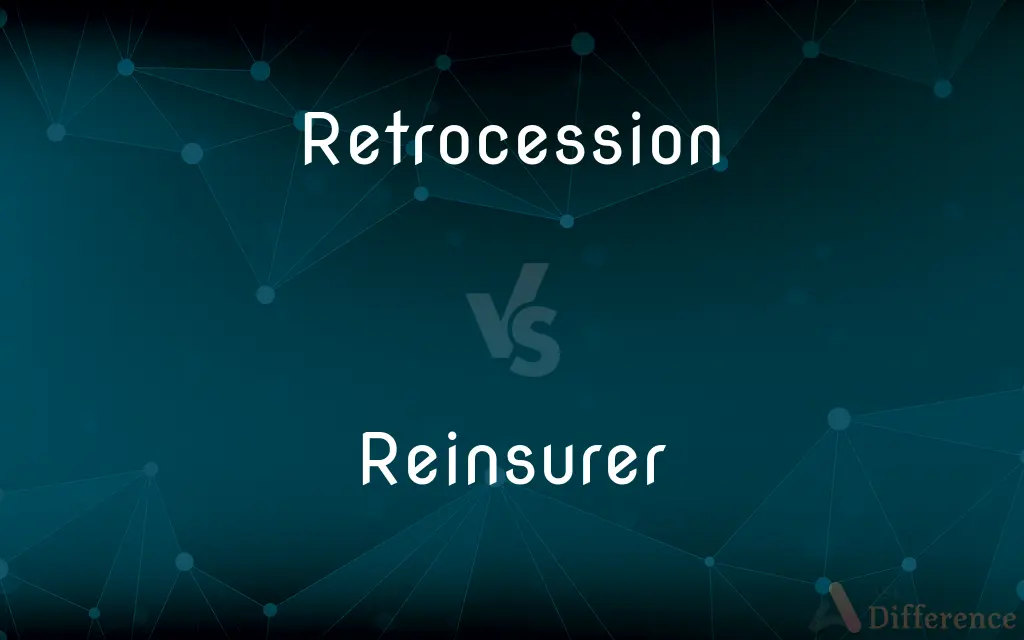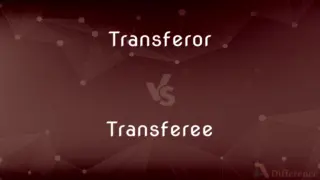Retrocession vs. Reinsurer — What's the Difference?
Edited by Tayyaba Rehman — By Urooj Arif — Updated on May 4, 2024
Retrocession involves a reinsurance company passing risk to another insurer, whereas a reinsurer is an entity that takes on risks from the primary insurers.

Difference Between Retrocession and Reinsurer
Table of Contents
ADVERTISEMENT
Key Differences
Retrocession is a mechanism used by reinsurance companies to cede part of the risk they have assumed to other reinsurers, effectively spreading the financial risk associated with their reinsurance agreements. Whereas, a reinsurer is typically a specialized company that provides financial protection to insurance companies by taking on some of the risks associated with the policies the primary insurer issues.
In retrocession, the focus is on risk management and financial stability for reinsurance companies, allowing them to maintain solvency and manage their risk exposures more effectively. On the other hand, a reinsurer directly impacts the insurance market by enabling insurance companies to underwrite policies that they would otherwise be unable to handle due to financial constraints.
The practice of retrocession can involve multiple layers of reinsurance, where risk is ceded multiple times among several reinsurers, creating a complex network of financial protection. Reinsurers, however, engage in a more straightforward relationship with primary insurers, directly taking on the risk in exchange for premiums.
Retrocession is typically used in specific scenarios where reinsurance companies need to optimize their risk portfolios or when the reinsurance market is particularly volatile. In contrast, reinsurers operate continuously in the insurance industry, providing necessary capacity and stability to the market.
While retrocession deals with transactions between reinsurance companies, reinsurers deal primarily with transactions between themselves and primary insurers, focusing on assuming specific parts of risk from original insurance policies.
ADVERTISEMENT
Comparison Chart
Definition
Transfer of risk from one reinsurer to another
Company taking risk from primary insurers
Primary Function
Risk distribution among reinsurers
Risk assumption from primary insurers
Engagement Level
Secondary, tertiary levels of risk transfer
Direct engagement with primary insurers
Market Impact
Stabilizes reinsurance market
Enables broader primary insurance coverage
Typical Use Cases
Managing solvency, risk portfolio optimization
Providing capacity, market stability
Compare with Definitions
Retrocession
A financial strategy to enhance risk distribution.
Through retrocession, the reinsurer diversified its risk more effectively.
Reinsurer
A company specializing in accepting risks from primary insurers.
The reinsurer provided a substantial cover for flood risks.
Retrocession
The act of transferring reinsurance risk to another company.
The company opted for retrocession to manage its excessive risk load.
Reinsurer
Essential for the viability of high-risk policies.
Without the reinsurer's involvement, covering natural disasters would be impossible.
Retrocession
A method used by reinsurers to spread their acquired risks.
Retrocession helped them stabilize their financial status during the market downturn.
Reinsurer
Often participates in global insurance markets.
The reinsurer expanded its services to include markets in Asia and Africa.
Retrocession
Specific to the reinsurance industry.
Retrocession is a common practice among European reinsurers.
Reinsurer
Operates to stabilize and provide capacity to the insurance market.
As a leading reinsurer, they facilitated new insurance products in emerging markets.
Retrocession
Often involves multiple layers of reinsurance.
Their retrocession chain included four different reinsurers.
Reinsurer
Engages directly with primary insurers for risk transfer.
The reinsurer signed several agreements with new insurance companies this year.
Retrocession
To go back; recede.
Reinsurer
To insure again, especially by transferring all or part of the risk in a contract to a new contract with another insurance company.
Retrocession
To cede or give back (a territory, for example); return.
Reinsurer
(insurance) A provider of reinsurance.
Retrocession
The transfer of risk from one reinsurer to another.
Reinsurer
One who gives reinsurance.
Retrocession
(legal) The return of land, rights, etc. previously ceded.
Retrocession
Metastasis of an eruption or tumour from the surface to the interior of the body.
Retrocession
The act of retroceding; a going back.
Retrocession
The act of retroceding.
Retrocession
The state of being retroceded, or granted back.
Retrocession
Metastasis of an eruption or a tumor from the surface to the interior of the body.
Common Curiosities
What types of risks do reinsurers typically accept?
Reinsurers typically accept a wide range of risks, including those from natural disasters, large-scale accidents, and financial crises.
How does a reinsurer operate?
A reinsurer provides financial protection to primary insurers by taking over some of their risks in exchange for premiums.
What is the main purpose of retrocession?
The main purpose of retrocession is to help reinsurers manage and distribute risk more effectively.
How does retrocession benefit the insurance industry?
Retrocession allows for greater stability and solvency within the reinsurance market, indirectly benefiting the entire insurance industry.
How is retrocession regulated?
Retrocession, like other forms of reinsurance, is subject to regulatory oversight which varies by jurisdiction to ensure solvency and market integrity.
Can retrocession be used for any type of reinsurance?
Retrocession can be used across various types of reinsurance, but it is more common in areas with high volatility or aggregate risks.
What determines the rates a reinsurer charges?
Rates are influenced by the risk level, historical data, market conditions, and the financial strength of the primary insurer.
What role do reinsurers play in managing catastrophic risks?
Reinsurers play a critical role by providing the necessary financial backing to cover catastrophic events, thus protecting primary insurers and insured parties.
What is retrocession in reinsurance?
Retrocession is the process where a reinsurance company transfers part of its risk to another reinsurer.
Can a company be both a reinsurer and a retrocessionaire?
Yes, many large reinsurance companies operate both as reinsurers and retrocessionaires, depending on their business strategies and risk management needs.
What is the relationship between a reinsurer and a primary insurer?
The relationship is based on financial transactions where the primary insurer transfers risk to the reinsurer in exchange for premium payments.
What happens if a reinsurer fails?
If a reinsurer fails, it can lead to significant financial losses for primary insurers and may impact insured entities.
What is the impact of reinsurance and retrocession on policyholders?
Both reinsurance and retrocession contribute to lower insurance costs and better risk management, benefiting policyholders by enhancing coverage availability and stability.
Why is retrocession important for reinsurance companies?
Retrocession is crucial for maintaining balance and financial health, especially in volatile or high-risk market conditions.
How do retrocession agreements affect reinsurance premiums?
Retrocession agreements can lead to more competitive premiums by spreading risk among more parties.
Share Your Discovery

Previous Comparison
Daisy vs. Margaret
Next Comparison
Hard vs. RigidAuthor Spotlight
Written by
Urooj ArifUrooj is a skilled content writer at Ask Difference, known for her exceptional ability to simplify complex topics into engaging and informative content. With a passion for research and a flair for clear, concise writing, she consistently delivers articles that resonate with our diverse audience.
Edited by
Tayyaba RehmanTayyaba Rehman is a distinguished writer, currently serving as a primary contributor to askdifference.com. As a researcher in semantics and etymology, Tayyaba's passion for the complexity of languages and their distinctions has found a perfect home on the platform. Tayyaba delves into the intricacies of language, distinguishing between commonly confused words and phrases, thereby providing clarity for readers worldwide.
















































